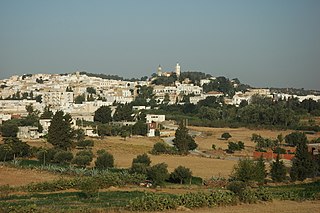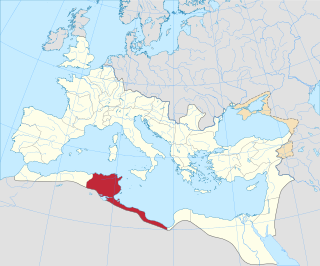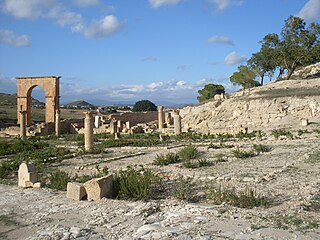
Abbir Maius also known as Abbiritanus was a Roman and Byzantine-era civitas (city), later municipium , in the Roman province of Africa proconsularis (today northern Tunisia). [1] [2]

Abbir Maius also known as Abbiritanus was a Roman and Byzantine-era civitas (city), later municipium , in the Roman province of Africa proconsularis (today northern Tunisia). [1] [2]
The town is identified through inscriptions [3] [4] with ruins near Henchir el Khandaq in Zaghouan Governorate (latitude 36.374, longitude 10.008826 ). This is near the village of Bir Halima between El Fahs and Zaghouan. [5] In Roman times this would have placed the city in the bread basket Medjerda River Valley, south of Carthage.
The city had an aqueduct, [6] completed by procurator Q. Geminius Faustus [7] and bath house. [8] And, [4] [9] like Thignica, was a civitas dependent of Carthage but under the emperor Caracalla was promoted to be a municipium. [10]
The city was also the seat of a bishopric, in the ecclesiastical province of Carthage. The only known Bishop of antiquity was Felix fl436-484, who was bishop of the town for 44 years and sent into exile under the Vandals. [11]
Although the bishopric ceased to effectively function at the end of the 7th century with the arrival of the Islamic armies, Titular Bishops have been be appointed to the diocese since the beginning of the 20th century. The bishop presently assigned to the Titular See is Ruben Caballero Labajo, Auxiliary Bishop of the Archdiocese of Cebu, appointed in 23 June 2022. [12]

Zaghouan is a town in the northern half of Tunisia.

Saldae was an important port city in the ancient Roman Empire, located at today's Béjaïa. It was generally a crossroads between eastern and western segments of Northern Africa, from the time of Carthage to the end of the Byzantine Empire from the continent.

Thuburbo Majus is a large Roman site in northern Tunisia. It is located roughly 60 km southwest of Carthage on a major African thoroughfare. This thoroughfare connects Carthage to the Sahara. Other towns along the way included Sbiba, Sufes, Sbeitla, and Sufetula. Parts of the old Roman road are in ruins, but others do remain.

Khamissa, ancient Thubursicum Numidarum or Thubursicum, is an Ancient Roman and Byzantine archeological site, in Souk Ahras Province of northeastern Algeria.

Kasserine is the capital city of the Kasserine Governorate, in west-central Tunisia. It is situated below Jebel ech Chambi, Tunisia's highest mountain. Its population is 114.463 (2020).

Pupput, also spelled "Putput", "Pudput", "Pulpud" and "Pulpite" in Latin, sometimes located in Souk el-Obiod ou Souk el-Abiod, is a Colonia in the Roman province of Africa which has been equated with an archaeological site in modern Tunisia. It is situated on the coast near the town of Hammamet, between the two wadis of Temad to the north and Moussa to the south. Much of the Pupput is buried under modern holiday developments which have been built over the major part of the site.

Volitanus also known as Voli and Bolitana was a Roman era civitas (town) of Africa Proconsularis, a suffragan metropolis of Carthage in Roman North Africa.

Abbir Germaniciana also known as Abir Cella is the name of a Roman and Byzantine-era city in the Roman province of Africa proconsularis. The city was also the seat of a bishopric, in the ecclesiastical province of Carthage, and is best known as the home town of the Pre Nicaean father, Cyprian, who was bishop of Abbir Germaniciana around 250AD.

Abthugni was an ancient city in Roman North Africa at present day Suwar (Henchir-es-Souar) in Tunisia. It was, in Roman times, in the province of Africa Proconsularis, Africa, and latter in Byzacena. In late antiquity Abthugni was also the seat of a bishop, and the diocese is a titular see of the Roman Catholic Church to this day.

Semta was a Roman era Municipium also known as Augustum Semta in Africa Proconsularis that is tentatively identified with ruins at Henchir Zemba (Dzemda) Carthage, Tunisia near the Oued el Kebir 20 km (12 mi) southwest of Zaghouan at 36.269282, 9.887345.

Pheradi Majius is a locality and archaeological site in Tunisia located at 36.250003°N 10.397047°E near the modern town of Sidi Khalifa in Sousse Governorate, Tunisia that is located at 36° 14′ 58″ N, 10° 23′ 57″E.
Drusiliana was a civitas (town) of Roman North Africa. Bingham called it a city of the Roman province of Mauretania Caesariensis. An inscription of Constantine the Great was found in the city ruins and it appears on the Tabula Peutingeriana The town has been tentatively identified with ruins near Khanguet-el-Kdim in northern Algeria. Located at 36.249547°N 8.907667°E. Epigraphical evidence suggest Constantine the Great undertook some works in the city in 312AD.
Crich El Oued, also known as Qarish el-Wadi, is a village in Tunisia, located between Bordj Toumi and Majaz al Bab in Béja Governorate east of Tunis. The village is on the Medjerda river at the confluence with the Oued el-Ahmar and the town has a mosque
Furni, also known as a Furnos Maius and Ain-Fourna, was a Roman era civitas of the Roman province of Africa Proconsularis on the Oued Kibira tributary of the Meliane River.

Douela or Douala is a village and locality in Tunisia, situated on the Mediterranean coast at latitude 36.8167°, longitude 10.5667° and near Sīdī `Ammār, Korbous, and El Bredj.

Sululos was a Roman era Municipium of the Roman province of Africa Proconsularis that flourished from which flourished from 30 BC - AD 640. The ancient town was officially known as Municipium Septimium Aurelium Severianum Apollinare Sululitanum and is tentatively identified with ruins at Bir-el-Heuch, (Bir-el-Ach) 36.461372, 9.605158 in what is today Tunisia.
Henchir-Boucha is a former Catholic diocese and archaeological site in Tunisia.

Henchir-Ed-Douamès is an archaeological site and locality in Tunisia, North Africa.
Gunugus or Gunugu was a Berber and Carthaginian town in northwest Africa in antiquity. It passed into Roman control during the Punic Wars and was the site of a colony of veteran soldiers. It survived the Vandals and Byzantines but was destroyed during the Muslim invasion of the area.

Tamada was an ancient Roman–Berber civitas in the province of Mauretania Caesariensis. The town lasted through the Byzantine Empire, Vandal Kingdom and Roman Empire into late antiquity, until at least the Muslim conquest of the Maghreb in the 7th century.